Business Culture and Responsibilities: A University of Oxford Report
VerifiedAdded on 2020/10/22
|9
|2110
|62
Report
AI Summary
This report analyzes business culture and responsibilities, focusing on waste minimization, diversity in the workforce, security, confidentiality, and risk management. The report, prepared for the University of Oxford, examines the benefits of waste reduction, suggests methods for waste minimization, and evaluates the impact of implemented changes. It also explains the concept of diversity in a business context, recognizes the benefits of a diverse workforce, and outlines ways organizations can promote diversity and summarizes legal and organizational guidelines governing diversity. Furthermore, the report emphasizes the importance of security and confidentiality, ensuring property and information security, and explaining the consequences of failing to maintain these standards. It concludes with a discussion of risk management, identifying potential risks, assessing their impact and likelihood, and suggesting methods to minimize them. The report references relevant books and journals to support its findings and recommendations.
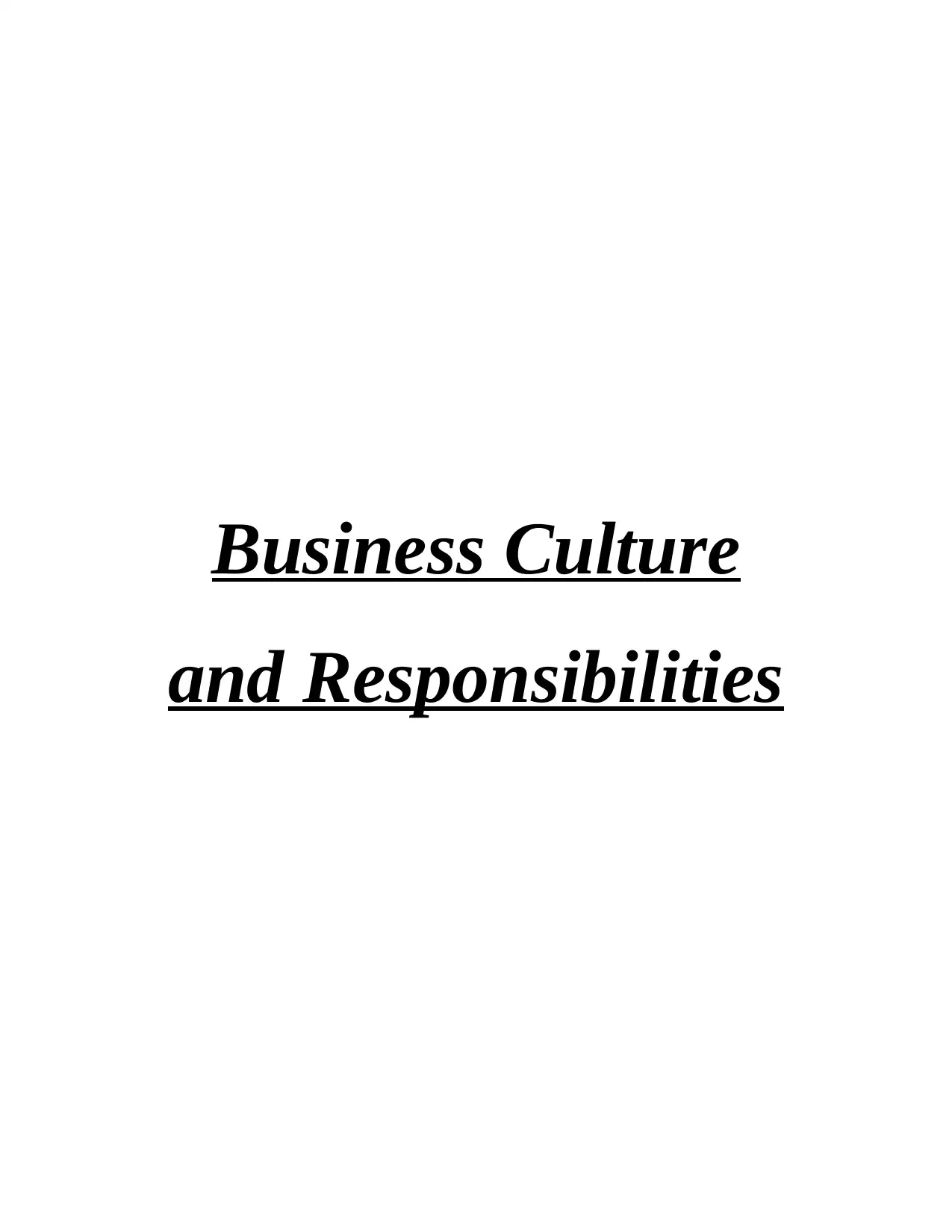
Business Culture
and Responsibilities
and Responsibilities
Paraphrase This Document
Need a fresh take? Get an instant paraphrase of this document with our AI Paraphraser
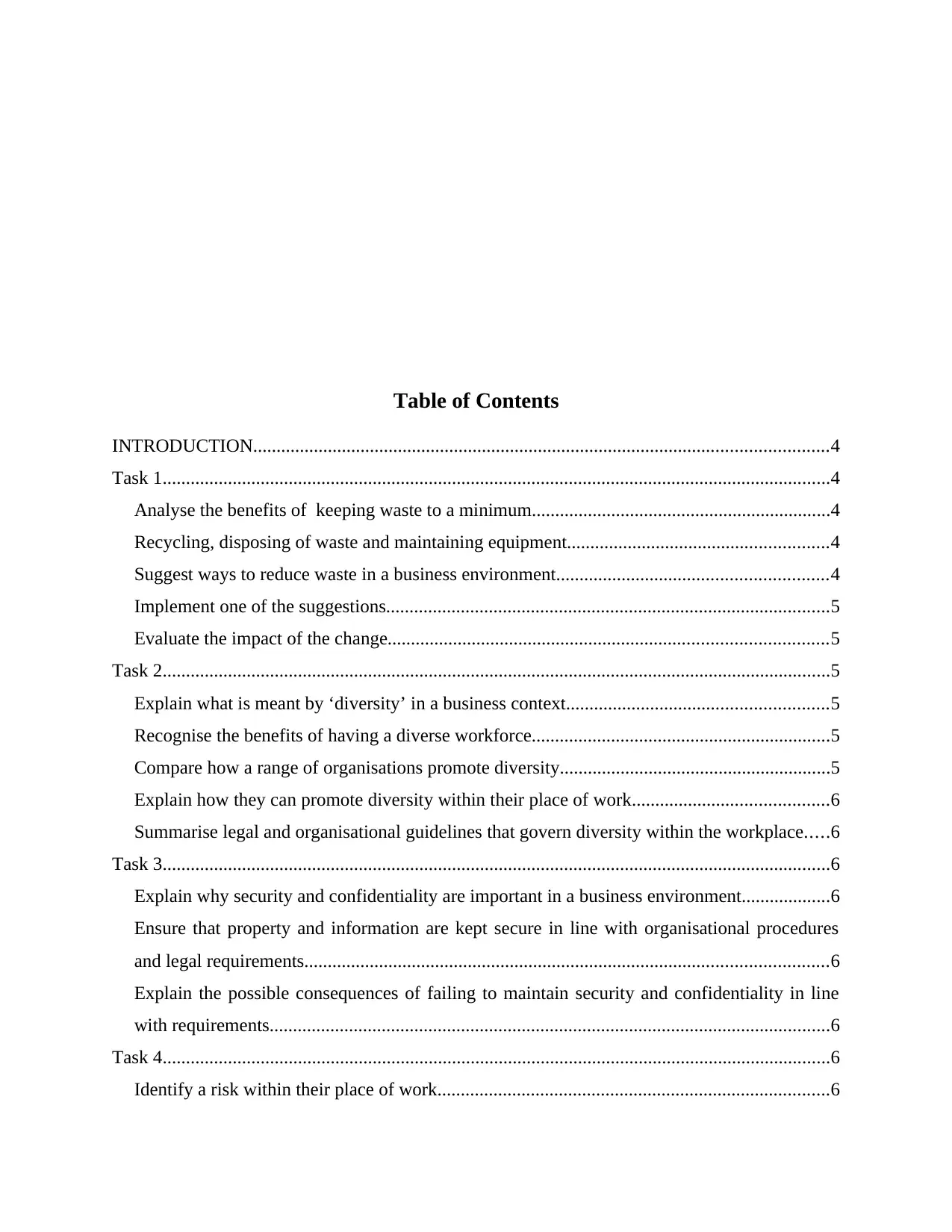
Table of Contents
INTRODUCTION...........................................................................................................................4
Task 1...............................................................................................................................................4
Analyse the benefits of keeping waste to a minimum................................................................4
Recycling, disposing of waste and maintaining equipment........................................................4
Suggest ways to reduce waste in a business environment..........................................................4
Implement one of the suggestions...............................................................................................5
Evaluate the impact of the change..............................................................................................5
Task 2...............................................................................................................................................5
Explain what is meant by ‘diversity’ in a business context........................................................5
Recognise the benefits of having a diverse workforce................................................................5
Compare how a range of organisations promote diversity..........................................................5
Explain how they can promote diversity within their place of work..........................................6
Summarise legal and organisational guidelines that govern diversity within the workplace.....6
Task 3...............................................................................................................................................6
Explain why security and confidentiality are important in a business environment...................6
Ensure that property and information are kept secure in line with organisational procedures
and legal requirements................................................................................................................6
Explain the possible consequences of failing to maintain security and confidentiality in line
with requirements........................................................................................................................6
Task 4...............................................................................................................................................6
Identify a risk within their place of work....................................................................................6
INTRODUCTION...........................................................................................................................4
Task 1...............................................................................................................................................4
Analyse the benefits of keeping waste to a minimum................................................................4
Recycling, disposing of waste and maintaining equipment........................................................4
Suggest ways to reduce waste in a business environment..........................................................4
Implement one of the suggestions...............................................................................................5
Evaluate the impact of the change..............................................................................................5
Task 2...............................................................................................................................................5
Explain what is meant by ‘diversity’ in a business context........................................................5
Recognise the benefits of having a diverse workforce................................................................5
Compare how a range of organisations promote diversity..........................................................5
Explain how they can promote diversity within their place of work..........................................6
Summarise legal and organisational guidelines that govern diversity within the workplace.....6
Task 3...............................................................................................................................................6
Explain why security and confidentiality are important in a business environment...................6
Ensure that property and information are kept secure in line with organisational procedures
and legal requirements................................................................................................................6
Explain the possible consequences of failing to maintain security and confidentiality in line
with requirements........................................................................................................................6
Task 4...............................................................................................................................................6
Identify a risk within their place of work....................................................................................6
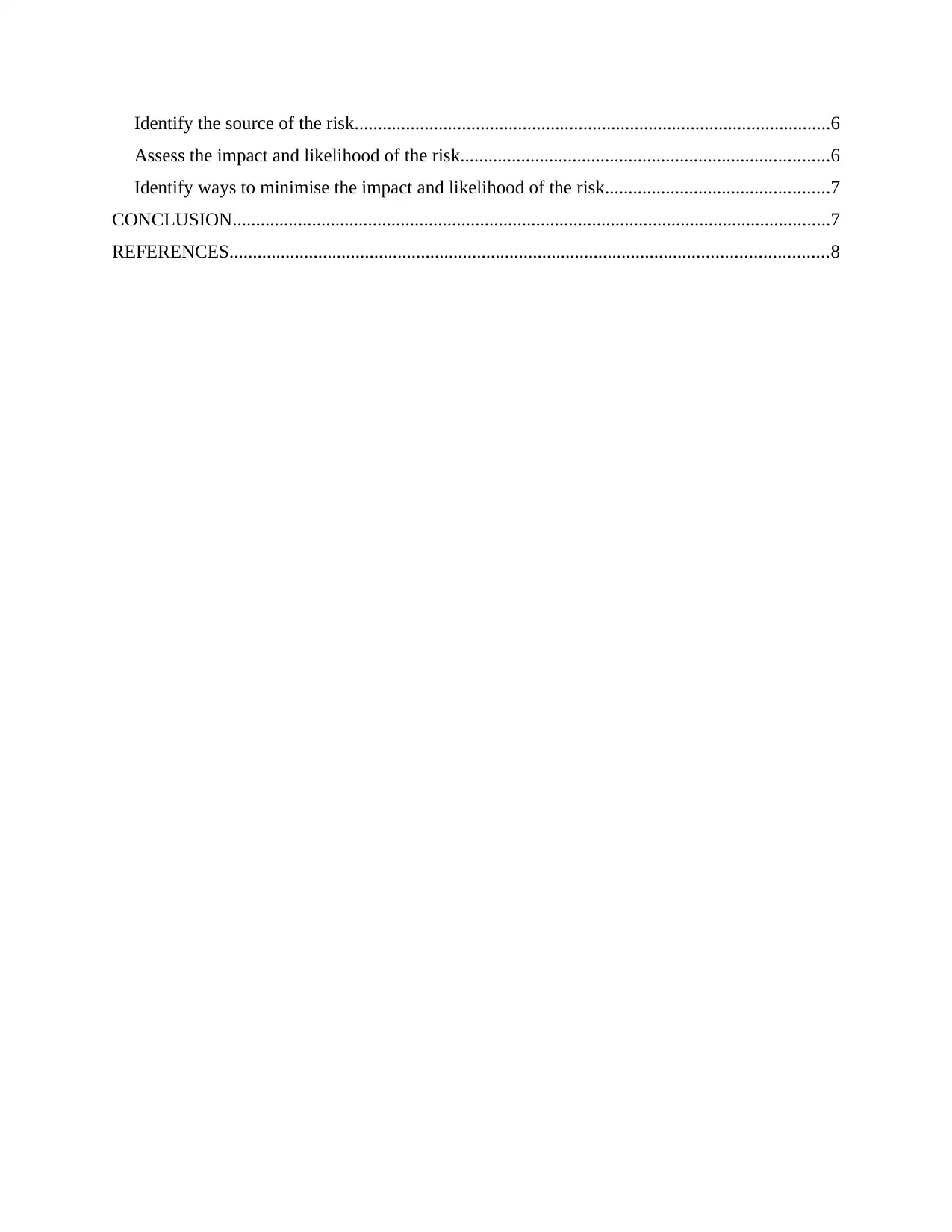
Identify the source of the risk......................................................................................................6
Assess the impact and likelihood of the risk...............................................................................6
Identify ways to minimise the impact and likelihood of the risk................................................7
CONCLUSION................................................................................................................................7
REFERENCES................................................................................................................................8
Assess the impact and likelihood of the risk...............................................................................6
Identify ways to minimise the impact and likelihood of the risk................................................7
CONCLUSION................................................................................................................................7
REFERENCES................................................................................................................................8
⊘ This is a preview!⊘
Do you want full access?
Subscribe today to unlock all pages.

Trusted by 1+ million students worldwide
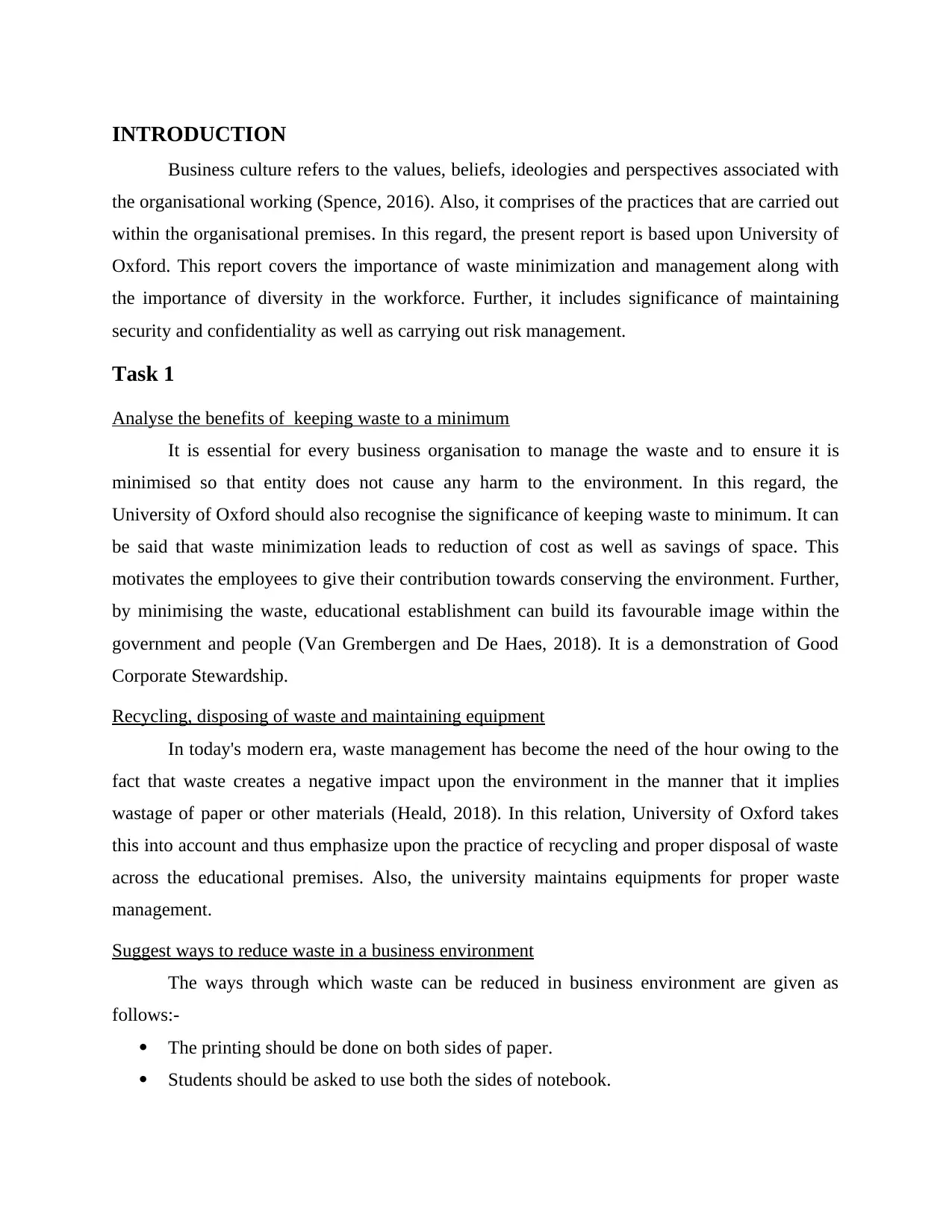
INTRODUCTION
Business culture refers to the values, beliefs, ideologies and perspectives associated with
the organisational working (Spence, 2016). Also, it comprises of the practices that are carried out
within the organisational premises. In this regard, the present report is based upon University of
Oxford. This report covers the importance of waste minimization and management along with
the importance of diversity in the workforce. Further, it includes significance of maintaining
security and confidentiality as well as carrying out risk management.
Task 1
Analyse the benefits of keeping waste to a minimum
It is essential for every business organisation to manage the waste and to ensure it is
minimised so that entity does not cause any harm to the environment. In this regard, the
University of Oxford should also recognise the significance of keeping waste to minimum. It can
be said that waste minimization leads to reduction of cost as well as savings of space. This
motivates the employees to give their contribution towards conserving the environment. Further,
by minimising the waste, educational establishment can build its favourable image within the
government and people (Van Grembergen and De Haes, 2018). It is a demonstration of Good
Corporate Stewardship.
Recycling, disposing of waste and maintaining equipment
In today's modern era, waste management has become the need of the hour owing to the
fact that waste creates a negative impact upon the environment in the manner that it implies
wastage of paper or other materials (Heald, 2018). In this relation, University of Oxford takes
this into account and thus emphasize upon the practice of recycling and proper disposal of waste
across the educational premises. Also, the university maintains equipments for proper waste
management.
Suggest ways to reduce waste in a business environment
The ways through which waste can be reduced in business environment are given as
follows:-
The printing should be done on both sides of paper.
Students should be asked to use both the sides of notebook.
Business culture refers to the values, beliefs, ideologies and perspectives associated with
the organisational working (Spence, 2016). Also, it comprises of the practices that are carried out
within the organisational premises. In this regard, the present report is based upon University of
Oxford. This report covers the importance of waste minimization and management along with
the importance of diversity in the workforce. Further, it includes significance of maintaining
security and confidentiality as well as carrying out risk management.
Task 1
Analyse the benefits of keeping waste to a minimum
It is essential for every business organisation to manage the waste and to ensure it is
minimised so that entity does not cause any harm to the environment. In this regard, the
University of Oxford should also recognise the significance of keeping waste to minimum. It can
be said that waste minimization leads to reduction of cost as well as savings of space. This
motivates the employees to give their contribution towards conserving the environment. Further,
by minimising the waste, educational establishment can build its favourable image within the
government and people (Van Grembergen and De Haes, 2018). It is a demonstration of Good
Corporate Stewardship.
Recycling, disposing of waste and maintaining equipment
In today's modern era, waste management has become the need of the hour owing to the
fact that waste creates a negative impact upon the environment in the manner that it implies
wastage of paper or other materials (Heald, 2018). In this relation, University of Oxford takes
this into account and thus emphasize upon the practice of recycling and proper disposal of waste
across the educational premises. Also, the university maintains equipments for proper waste
management.
Suggest ways to reduce waste in a business environment
The ways through which waste can be reduced in business environment are given as
follows:-
The printing should be done on both sides of paper.
Students should be asked to use both the sides of notebook.
Paraphrase This Document
Need a fresh take? Get an instant paraphrase of this document with our AI Paraphraser
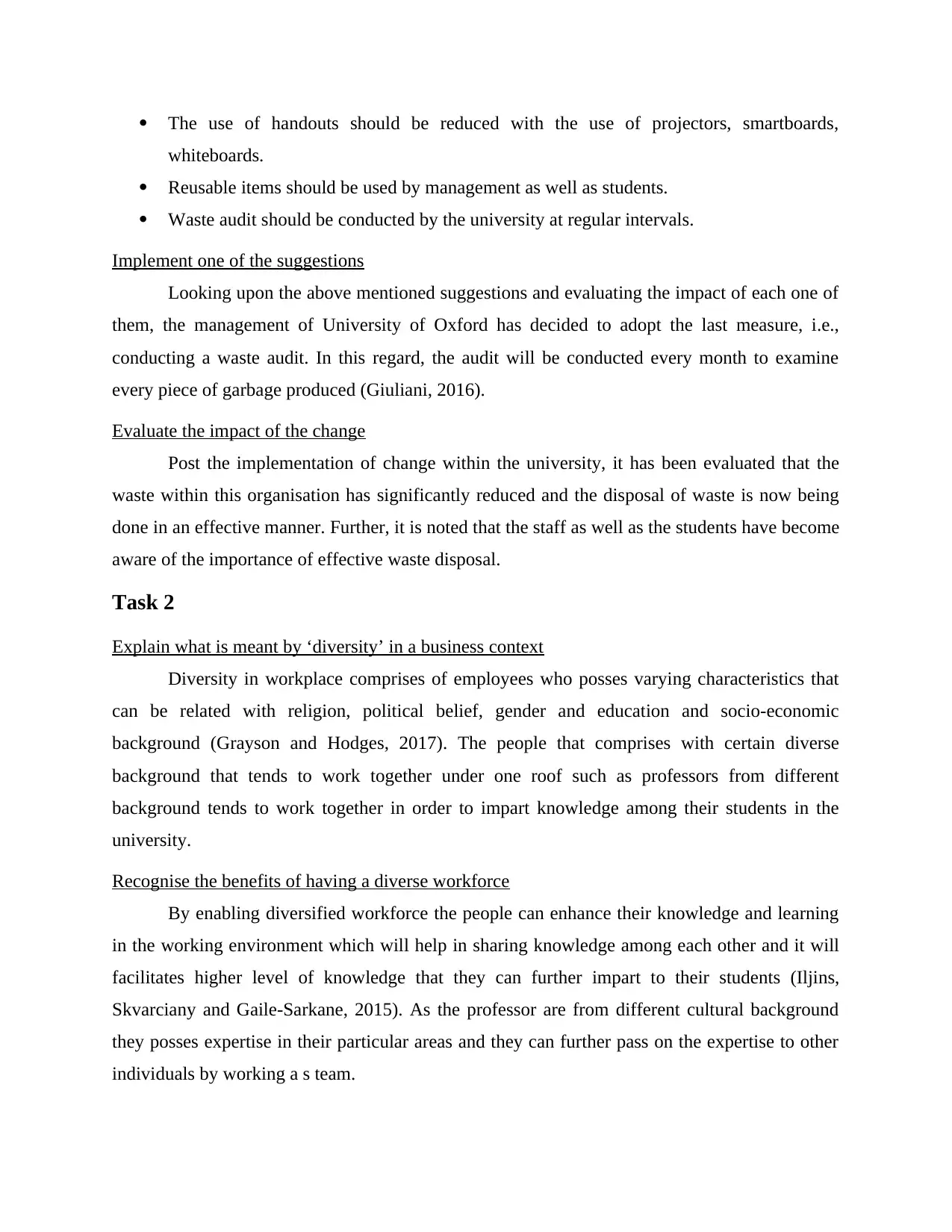
The use of handouts should be reduced with the use of projectors, smartboards,
whiteboards.
Reusable items should be used by management as well as students.
Waste audit should be conducted by the university at regular intervals.
Implement one of the suggestions
Looking upon the above mentioned suggestions and evaluating the impact of each one of
them, the management of University of Oxford has decided to adopt the last measure, i.e.,
conducting a waste audit. In this regard, the audit will be conducted every month to examine
every piece of garbage produced (Giuliani, 2016).
Evaluate the impact of the change
Post the implementation of change within the university, it has been evaluated that the
waste within this organisation has significantly reduced and the disposal of waste is now being
done in an effective manner. Further, it is noted that the staff as well as the students have become
aware of the importance of effective waste disposal.
Task 2
Explain what is meant by ‘diversity’ in a business context
Diversity in workplace comprises of employees who posses varying characteristics that
can be related with religion, political belief, gender and education and socio-economic
background (Grayson and Hodges, 2017). The people that comprises with certain diverse
background that tends to work together under one roof such as professors from different
background tends to work together in order to impart knowledge among their students in the
university.
Recognise the benefits of having a diverse workforce
By enabling diversified workforce the people can enhance their knowledge and learning
in the working environment which will help in sharing knowledge among each other and it will
facilitates higher level of knowledge that they can further impart to their students (Iljins,
Skvarciany and Gaile-Sarkane, 2015). As the professor are from different cultural background
they posses expertise in their particular areas and they can further pass on the expertise to other
individuals by working a s team.
whiteboards.
Reusable items should be used by management as well as students.
Waste audit should be conducted by the university at regular intervals.
Implement one of the suggestions
Looking upon the above mentioned suggestions and evaluating the impact of each one of
them, the management of University of Oxford has decided to adopt the last measure, i.e.,
conducting a waste audit. In this regard, the audit will be conducted every month to examine
every piece of garbage produced (Giuliani, 2016).
Evaluate the impact of the change
Post the implementation of change within the university, it has been evaluated that the
waste within this organisation has significantly reduced and the disposal of waste is now being
done in an effective manner. Further, it is noted that the staff as well as the students have become
aware of the importance of effective waste disposal.
Task 2
Explain what is meant by ‘diversity’ in a business context
Diversity in workplace comprises of employees who posses varying characteristics that
can be related with religion, political belief, gender and education and socio-economic
background (Grayson and Hodges, 2017). The people that comprises with certain diverse
background that tends to work together under one roof such as professors from different
background tends to work together in order to impart knowledge among their students in the
university.
Recognise the benefits of having a diverse workforce
By enabling diversified workforce the people can enhance their knowledge and learning
in the working environment which will help in sharing knowledge among each other and it will
facilitates higher level of knowledge that they can further impart to their students (Iljins,
Skvarciany and Gaile-Sarkane, 2015). As the professor are from different cultural background
they posses expertise in their particular areas and they can further pass on the expertise to other
individuals by working a s team.
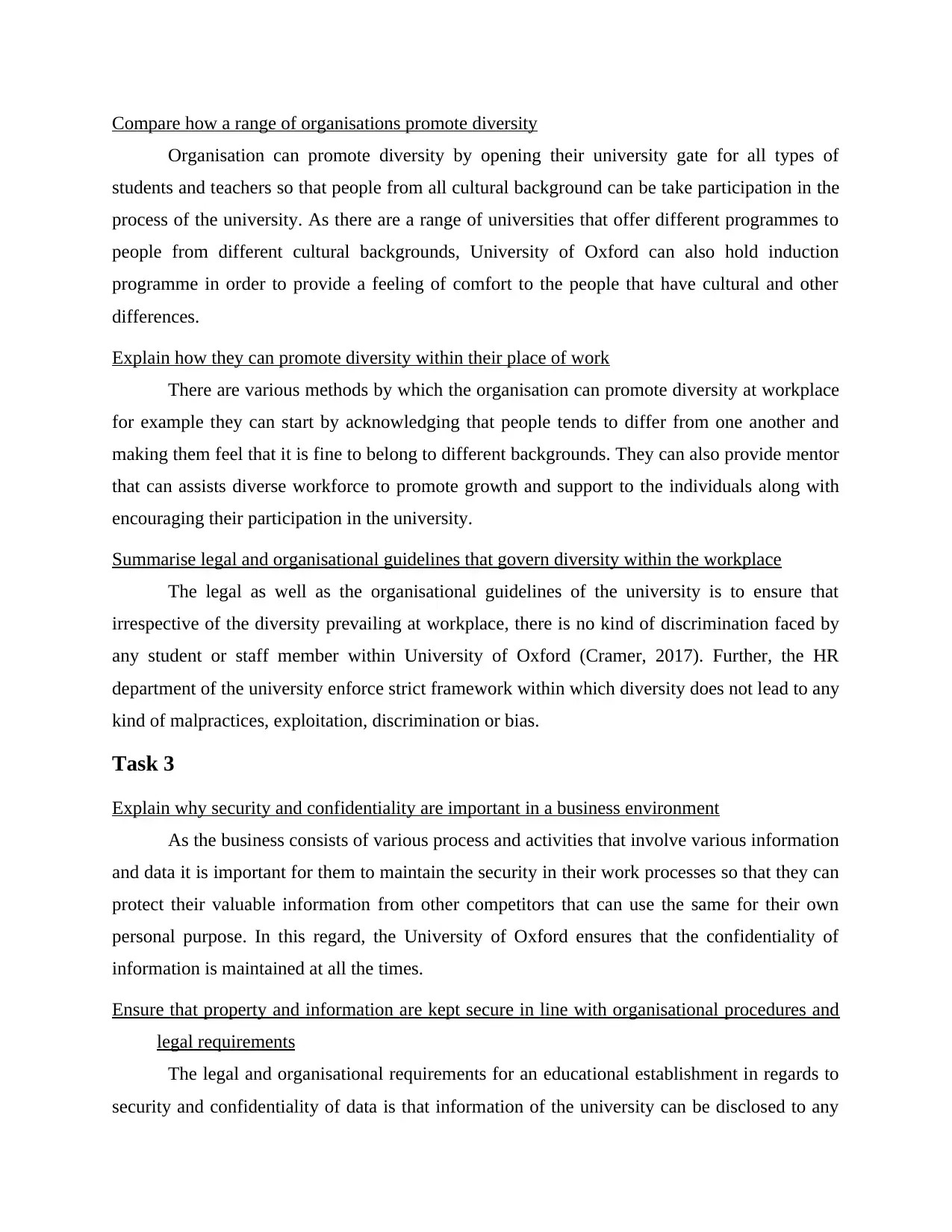
Compare how a range of organisations promote diversity
Organisation can promote diversity by opening their university gate for all types of
students and teachers so that people from all cultural background can be take participation in the
process of the university. As there are a range of universities that offer different programmes to
people from different cultural backgrounds, University of Oxford can also hold induction
programme in order to provide a feeling of comfort to the people that have cultural and other
differences.
Explain how they can promote diversity within their place of work
There are various methods by which the organisation can promote diversity at workplace
for example they can start by acknowledging that people tends to differ from one another and
making them feel that it is fine to belong to different backgrounds. They can also provide mentor
that can assists diverse workforce to promote growth and support to the individuals along with
encouraging their participation in the university.
Summarise legal and organisational guidelines that govern diversity within the workplace
The legal as well as the organisational guidelines of the university is to ensure that
irrespective of the diversity prevailing at workplace, there is no kind of discrimination faced by
any student or staff member within University of Oxford (Cramer, 2017). Further, the HR
department of the university enforce strict framework within which diversity does not lead to any
kind of malpractices, exploitation, discrimination or bias.
Task 3
Explain why security and confidentiality are important in a business environment
As the business consists of various process and activities that involve various information
and data it is important for them to maintain the security in their work processes so that they can
protect their valuable information from other competitors that can use the same for their own
personal purpose. In this regard, the University of Oxford ensures that the confidentiality of
information is maintained at all the times.
Ensure that property and information are kept secure in line with organisational procedures and
legal requirements
The legal and organisational requirements for an educational establishment in regards to
security and confidentiality of data is that information of the university can be disclosed to any
Organisation can promote diversity by opening their university gate for all types of
students and teachers so that people from all cultural background can be take participation in the
process of the university. As there are a range of universities that offer different programmes to
people from different cultural backgrounds, University of Oxford can also hold induction
programme in order to provide a feeling of comfort to the people that have cultural and other
differences.
Explain how they can promote diversity within their place of work
There are various methods by which the organisation can promote diversity at workplace
for example they can start by acknowledging that people tends to differ from one another and
making them feel that it is fine to belong to different backgrounds. They can also provide mentor
that can assists diverse workforce to promote growth and support to the individuals along with
encouraging their participation in the university.
Summarise legal and organisational guidelines that govern diversity within the workplace
The legal as well as the organisational guidelines of the university is to ensure that
irrespective of the diversity prevailing at workplace, there is no kind of discrimination faced by
any student or staff member within University of Oxford (Cramer, 2017). Further, the HR
department of the university enforce strict framework within which diversity does not lead to any
kind of malpractices, exploitation, discrimination or bias.
Task 3
Explain why security and confidentiality are important in a business environment
As the business consists of various process and activities that involve various information
and data it is important for them to maintain the security in their work processes so that they can
protect their valuable information from other competitors that can use the same for their own
personal purpose. In this regard, the University of Oxford ensures that the confidentiality of
information is maintained at all the times.
Ensure that property and information are kept secure in line with organisational procedures and
legal requirements
The legal and organisational requirements for an educational establishment in regards to
security and confidentiality of data is that information of the university can be disclosed to any
⊘ This is a preview!⊘
Do you want full access?
Subscribe today to unlock all pages.

Trusted by 1+ million students worldwide
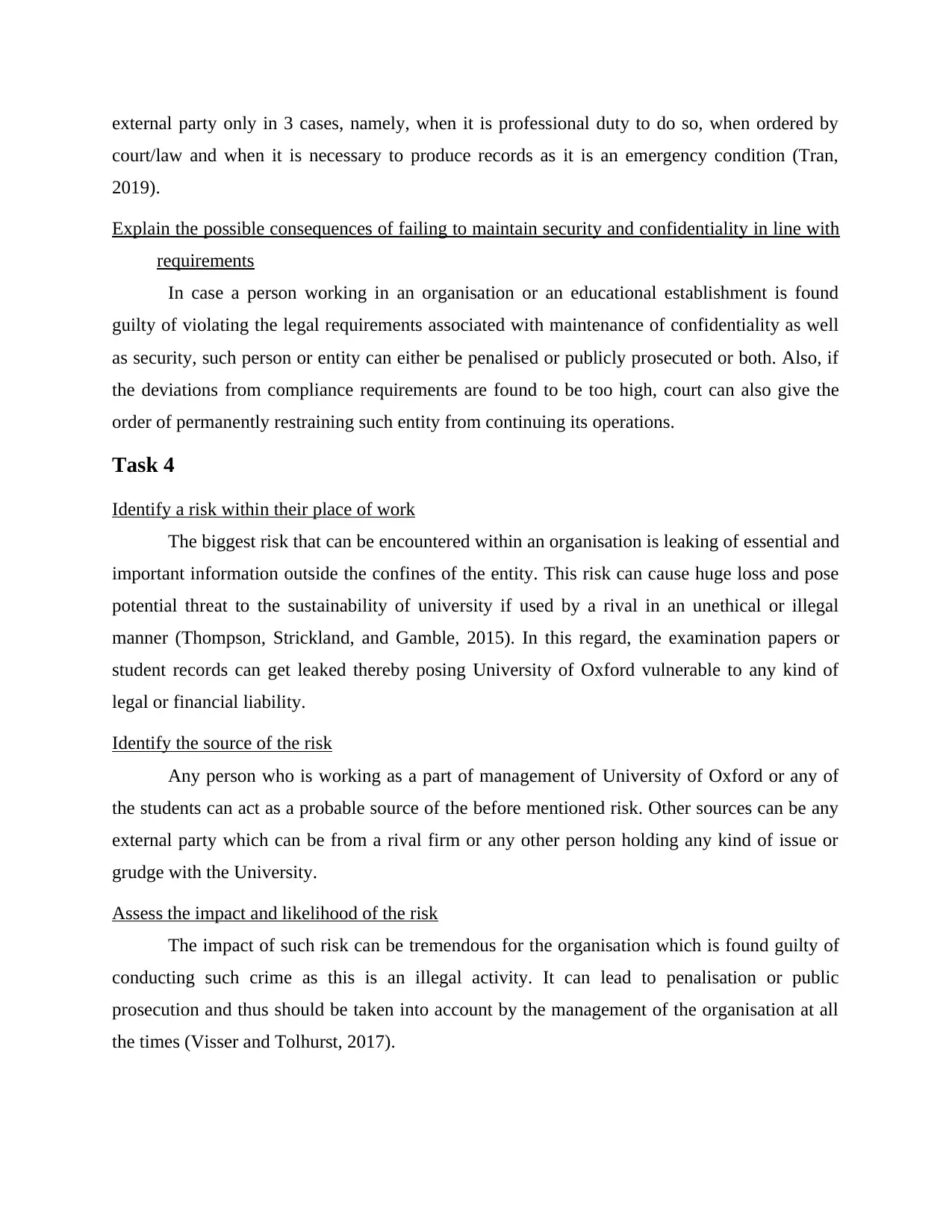
external party only in 3 cases, namely, when it is professional duty to do so, when ordered by
court/law and when it is necessary to produce records as it is an emergency condition (Tran,
2019).
Explain the possible consequences of failing to maintain security and confidentiality in line with
requirements
In case a person working in an organisation or an educational establishment is found
guilty of violating the legal requirements associated with maintenance of confidentiality as well
as security, such person or entity can either be penalised or publicly prosecuted or both. Also, if
the deviations from compliance requirements are found to be too high, court can also give the
order of permanently restraining such entity from continuing its operations.
Task 4
Identify a risk within their place of work
The biggest risk that can be encountered within an organisation is leaking of essential and
important information outside the confines of the entity. This risk can cause huge loss and pose
potential threat to the sustainability of university if used by a rival in an unethical or illegal
manner (Thompson, Strickland, and Gamble, 2015). In this regard, the examination papers or
student records can get leaked thereby posing University of Oxford vulnerable to any kind of
legal or financial liability.
Identify the source of the risk
Any person who is working as a part of management of University of Oxford or any of
the students can act as a probable source of the before mentioned risk. Other sources can be any
external party which can be from a rival firm or any other person holding any kind of issue or
grudge with the University.
Assess the impact and likelihood of the risk
The impact of such risk can be tremendous for the organisation which is found guilty of
conducting such crime as this is an illegal activity. It can lead to penalisation or public
prosecution and thus should be taken into account by the management of the organisation at all
the times (Visser and Tolhurst, 2017).
court/law and when it is necessary to produce records as it is an emergency condition (Tran,
2019).
Explain the possible consequences of failing to maintain security and confidentiality in line with
requirements
In case a person working in an organisation or an educational establishment is found
guilty of violating the legal requirements associated with maintenance of confidentiality as well
as security, such person or entity can either be penalised or publicly prosecuted or both. Also, if
the deviations from compliance requirements are found to be too high, court can also give the
order of permanently restraining such entity from continuing its operations.
Task 4
Identify a risk within their place of work
The biggest risk that can be encountered within an organisation is leaking of essential and
important information outside the confines of the entity. This risk can cause huge loss and pose
potential threat to the sustainability of university if used by a rival in an unethical or illegal
manner (Thompson, Strickland, and Gamble, 2015). In this regard, the examination papers or
student records can get leaked thereby posing University of Oxford vulnerable to any kind of
legal or financial liability.
Identify the source of the risk
Any person who is working as a part of management of University of Oxford or any of
the students can act as a probable source of the before mentioned risk. Other sources can be any
external party which can be from a rival firm or any other person holding any kind of issue or
grudge with the University.
Assess the impact and likelihood of the risk
The impact of such risk can be tremendous for the organisation which is found guilty of
conducting such crime as this is an illegal activity. It can lead to penalisation or public
prosecution and thus should be taken into account by the management of the organisation at all
the times (Visser and Tolhurst, 2017).
Paraphrase This Document
Need a fresh take? Get an instant paraphrase of this document with our AI Paraphraser
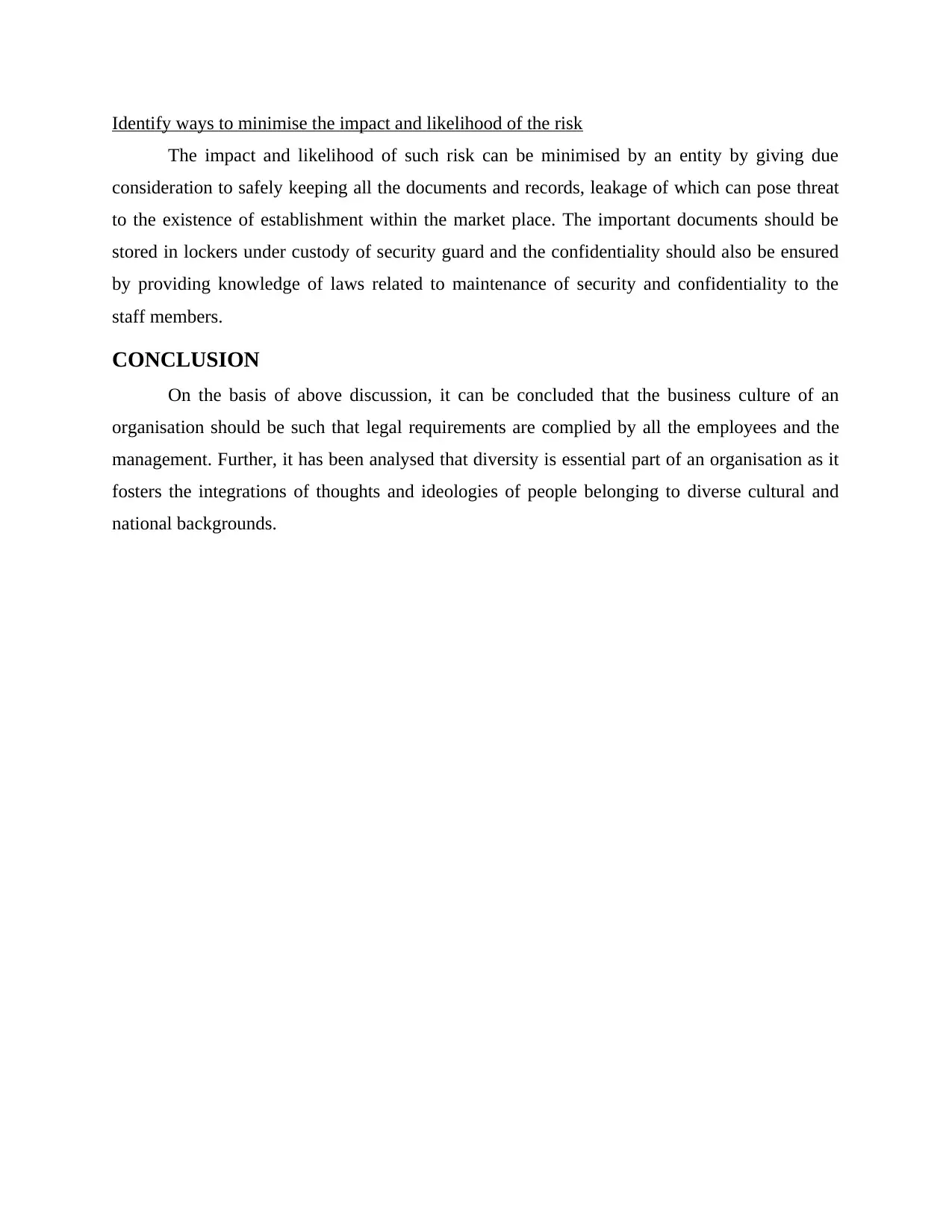
Identify ways to minimise the impact and likelihood of the risk
The impact and likelihood of such risk can be minimised by an entity by giving due
consideration to safely keeping all the documents and records, leakage of which can pose threat
to the existence of establishment within the market place. The important documents should be
stored in lockers under custody of security guard and the confidentiality should also be ensured
by providing knowledge of laws related to maintenance of security and confidentiality to the
staff members.
CONCLUSION
On the basis of above discussion, it can be concluded that the business culture of an
organisation should be such that legal requirements are complied by all the employees and the
management. Further, it has been analysed that diversity is essential part of an organisation as it
fosters the integrations of thoughts and ideologies of people belonging to diverse cultural and
national backgrounds.
The impact and likelihood of such risk can be minimised by an entity by giving due
consideration to safely keeping all the documents and records, leakage of which can pose threat
to the existence of establishment within the market place. The important documents should be
stored in lockers under custody of security guard and the confidentiality should also be ensured
by providing knowledge of laws related to maintenance of security and confidentiality to the
staff members.
CONCLUSION
On the basis of above discussion, it can be concluded that the business culture of an
organisation should be such that legal requirements are complied by all the employees and the
management. Further, it has been analysed that diversity is essential part of an organisation as it
fosters the integrations of thoughts and ideologies of people belonging to diverse cultural and
national backgrounds.
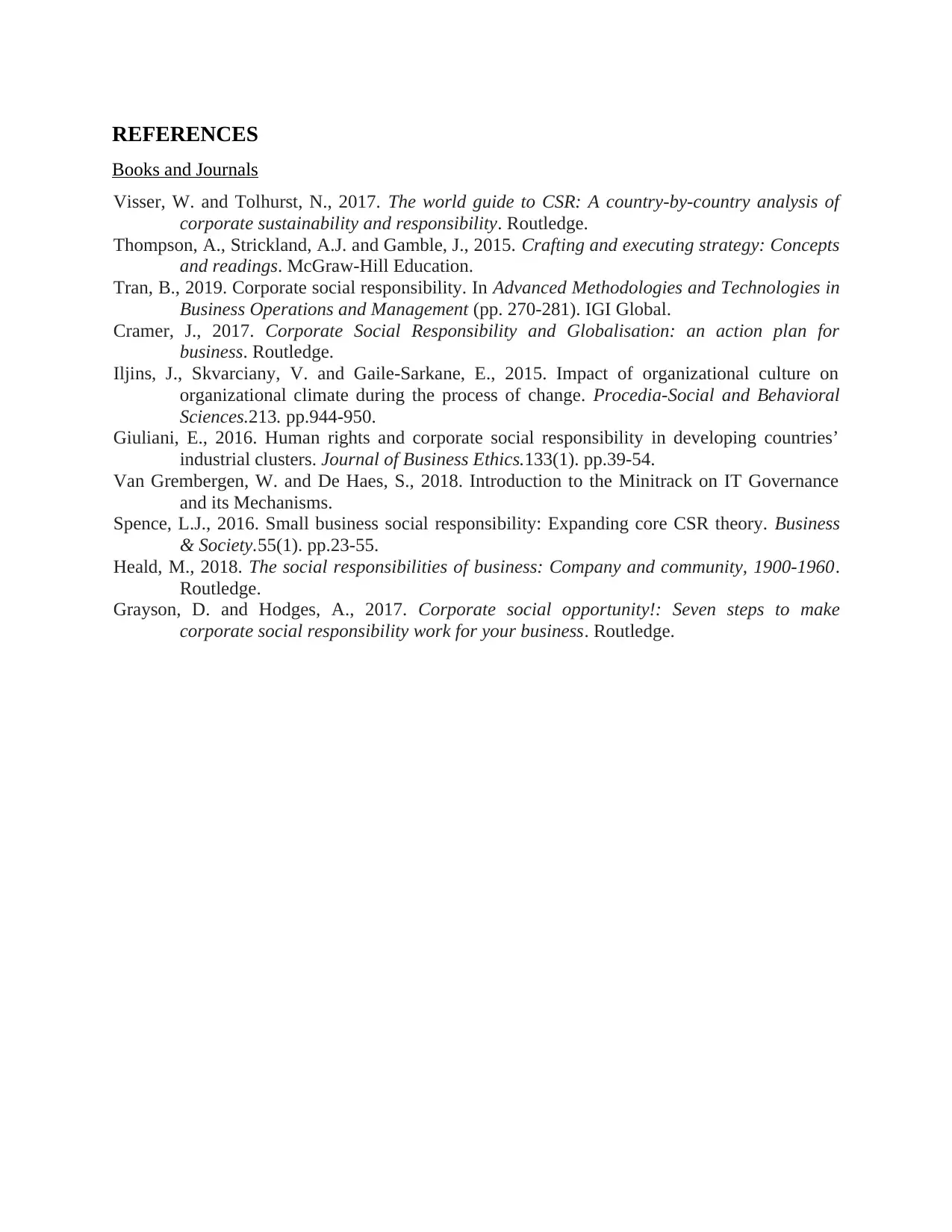
REFERENCES
Books and Journals
Visser, W. and Tolhurst, N., 2017. The world guide to CSR: A country-by-country analysis of
corporate sustainability and responsibility. Routledge.
Thompson, A., Strickland, A.J. and Gamble, J., 2015. Crafting and executing strategy: Concepts
and readings. McGraw-Hill Education.
Tran, B., 2019. Corporate social responsibility. In Advanced Methodologies and Technologies in
Business Operations and Management (pp. 270-281). IGI Global.
Cramer, J., 2017. Corporate Social Responsibility and Globalisation: an action plan for
business. Routledge.
Iljins, J., Skvarciany, V. and Gaile-Sarkane, E., 2015. Impact of organizational culture on
organizational climate during the process of change. Procedia-Social and Behavioral
Sciences.213. pp.944-950.
Giuliani, E., 2016. Human rights and corporate social responsibility in developing countries’
industrial clusters. Journal of Business Ethics.133(1). pp.39-54.
Van Grembergen, W. and De Haes, S., 2018. Introduction to the Minitrack on IT Governance
and its Mechanisms.
Spence, L.J., 2016. Small business social responsibility: Expanding core CSR theory. Business
& Society.55(1). pp.23-55.
Heald, M., 2018. The social responsibilities of business: Company and community, 1900-1960.
Routledge.
Grayson, D. and Hodges, A., 2017. Corporate social opportunity!: Seven steps to make
corporate social responsibility work for your business. Routledge.
Books and Journals
Visser, W. and Tolhurst, N., 2017. The world guide to CSR: A country-by-country analysis of
corporate sustainability and responsibility. Routledge.
Thompson, A., Strickland, A.J. and Gamble, J., 2015. Crafting and executing strategy: Concepts
and readings. McGraw-Hill Education.
Tran, B., 2019. Corporate social responsibility. In Advanced Methodologies and Technologies in
Business Operations and Management (pp. 270-281). IGI Global.
Cramer, J., 2017. Corporate Social Responsibility and Globalisation: an action plan for
business. Routledge.
Iljins, J., Skvarciany, V. and Gaile-Sarkane, E., 2015. Impact of organizational culture on
organizational climate during the process of change. Procedia-Social and Behavioral
Sciences.213. pp.944-950.
Giuliani, E., 2016. Human rights and corporate social responsibility in developing countries’
industrial clusters. Journal of Business Ethics.133(1). pp.39-54.
Van Grembergen, W. and De Haes, S., 2018. Introduction to the Minitrack on IT Governance
and its Mechanisms.
Spence, L.J., 2016. Small business social responsibility: Expanding core CSR theory. Business
& Society.55(1). pp.23-55.
Heald, M., 2018. The social responsibilities of business: Company and community, 1900-1960.
Routledge.
Grayson, D. and Hodges, A., 2017. Corporate social opportunity!: Seven steps to make
corporate social responsibility work for your business. Routledge.
⊘ This is a preview!⊘
Do you want full access?
Subscribe today to unlock all pages.

Trusted by 1+ million students worldwide
1 out of 9
Related Documents
Your All-in-One AI-Powered Toolkit for Academic Success.
+13062052269
info@desklib.com
Available 24*7 on WhatsApp / Email
![[object Object]](/_next/static/media/star-bottom.7253800d.svg)
Unlock your academic potential
Copyright © 2020–2025 A2Z Services. All Rights Reserved. Developed and managed by ZUCOL.





